Flying Termites Sydney Australia?
What does it mean when you see swarming, flying termites in Sydney, Australia? Are those frightening critters invading your home “swarming termites” or just flying ants?
Sydney Swarming Termites
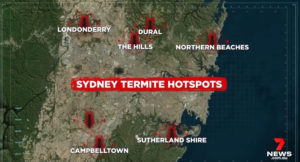
Here is our FAQ list of common questions about Sydney flying termites:
Have you ever experienced the horror of swarming termites? They can be a frightening sight for a lot of home owners living in Sydney, as hidden termite damage may run into thousand of dollars before it is discovered.
Our swarming termites expert Bruce Gow has been asked a lot of questions about these “alates” or winged insects over the years.
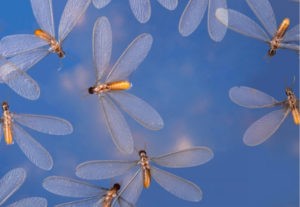
So here is a list of the more common ones & the answers to them are linked at the bottom of the list.
1. How do you get rid of flying termites?
2. Why do they suddenly appear?
3. Why do swarming termites mean serious trouble?
4. How long do they last?
5 Where do they come from?
6. Why do they come out after rain?
7. What is the difference between flying termites vs flying ants?
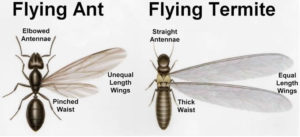
8. What if they appear outside of my house?
9. What do they look like?

10. What if swarming termites are in my house?
11. Do flying termites eat wood?
12. Where do they come from?
13. How long do they live?
14. What happens if a termite flies into my house?
15. How many Australian termite species are there?
16. Do winged termites cause any damage?
17. Why do they appear after rain?
18. Are flying termites attracted to light?
21. What is their lifespan?
19. Do they bite?
20. How do I get rid of them in my house naturally?
21. How do I tell the difference between flying ants versus termites?
22. What are flying bugs that look like termites?
23. How harmful are flying termites?
24. Should I worry about flying termites?
Answers and Termite Expert Information
1. How do you get rid of flying termites?
A. They really aren’t that hard to get rid of and they don’t cause any timber damage. Their offspring WILL cause timber damage after 2 or 3 years after their nest matures.
The easiest way is to vacuum them up. They may be easily killed with any knock down aerosol spray. If they are coming out of the timbers of your house or a nearby tree, expert help is needed.
2. Why do they suddenly appear in Sydney?
A. Alates or swarmers will leave the confines of their nest once they mature and the conditions are right. The right conditions are a warm spring to summer day when the humidity is high enough.
3. Why do swarming termites (swarmers) mean serious trouble?
A. They raise red flags because these potential reproductive termites can form colonies within your property. They can cause tens of thousands of dollars worth of damage in concealed areas.
By the time that you find out where they have infested, substantial economic damage may be caused to structural areas of your home.
4. How long do they last in Sydney, Australia?
A winged termite in Australia will only last 1-2 days before dries out, gets eaten by prey or otherwise killed. If it reaches the soil , mates and forms a colony, they can last up to around 20 years.
The swarming of winged termites will only last from only a few minutes up to an hour.
5 Where do they come from in Sydney?
There are two types of nests that they can emerge from, subterranean (underground) and aboreal ( in trees). If you are unlucky enough to have them nest in your home, they can come from your subfloor or internal walls.
6. Why do they come out after rain?
7. What is the difference between flying termites vs flying ants?
Do termites have wings?
Yes they have 2 sets of equal length wings. Flying ants also have 2 sets of wings, but the front set are larger than the rear set.
8. Do termites fly?
Yes, they can. But not all of the castes have this ability, only the potential reproductives . Winged termites can fly for a short period of time before they lose their wings.
9. What does it mean when you see flying termites?
The presence of flying termites, also known as termite swarmers or alates, is often a sign of a mature termite colony nearby.
When I say nearby, that could mean from inside your home to over a kilometere away as they can fly for a while after being carried on a warm and humid breeze.
10. What if swarming termites are in my house?
Termite swarms usually occur when a colony has reached a certain size and is looking to establish new colonies.
This typically happens during the warmer months of November December and January in Australia, often after rain.
When you see flying termites, it means that the colony has produced reproductive individuals with wings (alates) whose primary purpose is to leave the nest, mate, and establish new colonies.
These swarmers are often mistaken for flying ants, but there are key differences between the two.
If you observe flying termites, it’s important to take action promptly, as it may indicate the presence of a termite infestation.
Try and locate the source if they are originating in a large tree or a stump.
Termites can cause significant damage to timber structures and other materials containing cellulose.
If you’re unsure whether you’re dealing with flying termites or another flying insect, consider consulting with an A1 pest control professional for an accurate identification and appropriate treatment options if needed.
Regular inspections and preventive measures can help protect your property from termite damage. Call or email us now if you would like quick action to ease your mind.
Call Bruce directly in Sydney from 9am to 5pm Monday to Friday. Or 10am to 2pm on Saturday
Bruce Gow
A1 Pest Control
Certain types of termites in certain stages of their life cycle have wings. There are 4 castes of a termite colony, and they include:
Termite king & queen
Workers
Soldiers
Alates – Flying or winged termites
Pseudergates – Wingless nymph worker
N.B. only the alate caste has wings.
Why Termites Lick Their Own Queen to Death
What are flying termites?
Termites with wings are a potentially reproductive caste of termites commonly referred to as “swarmers”. They cannot cause damage to structural timbers of your home or office, but they are a red flag that an active colony is nearby.
How do flying termites get in your house?
One of the most common ways for termites to get in your home is through wood-to-soil contact, including deck posts, doorframes, and porch steps or supports. They can also enter through cracks in brick mortar and cracks in the foundation.
What do flying termites look like?
Depending on the species, they are half to one centimetre long in size. They are usually light in colour. They have 2 pairs of same sized wings.
What colour are termite wings, and how do they look?
The colour of termite wings is either white or translucent. They have 2 pairs of wings, and both pairs are of the same size.
Why do flying termites mean serious trouble?
Flying termites could possibly be your first clue that damage to your property may be current.
Worker termites are the caste that causes structural timber damage to your home.
They bring mud mixed with their faeces, making mud trails and nesting into building materials.
Termites will cause paintwork to ripple and timbers to distort as they weaken.
Termite colonies usually mature in about three to six years and produce alates.
During this time, the termite workers feed on wood to cause costly damage to your home or property. The worker stage termites eat the soft interior portions of the wood, leaving the outer shell intact.
Later on you will get to see the early warning signs of mud leads, dimpling of timber and wet gyprock or plaster wall linings.
Why do flying termites swarm?
Termites swarm to breed and start new colonies that mark the beginning of the termite life cycle.
What attracts them to windows?
Winged termites are highly attracted to light. They fly to the sources of light, such as street lamps, and swarm around them.
Do termites shed their wings?
Yes. After they have successfully mated with other termites, they land, shed their wings, and begin the process of creating a new colony.
How long do flying termites last?
They last only for a few minutes. The swarmers fly a short distance, fall to the ground, and shed their wings. Most of the swarmers die within a day or so of the swarm.
What do they eat?
Worker and soldiers eat timber, wooden items and in fact anything containing cellulose. They can even eat newspapers, cardboard, books, boxes, and sometimes your furniture!
But the good news is that the swarming termites with wings aren’t interested in eating anything at all. Their main focus is to fly out from the colony, land and mate before building a new home.
Are flying ants termites?
No. While both species have four wings, there are a few differences between ants with wings and winged termites:
Flying termites vs. flying ants
FLYING TERMITES
FLYING ANTS
Wings 2 pairs of uniform-sized wings in white or translucent color Front wings longer than the back wings
Colour Tan or beige in colour depending on the species. Mostly red or black colour.
Waist Thick waist. No constriction between the abdomen and thorax. Thin waist. There is a constriction between the abdomen and thorax
Antennae Straight antennae Bent antennae
How big are flying termites in Sydney, Australia?
Depending on the species, the size of flying termites can range from 5-10 millimetres long in size.
Why do termite wings fall off?
Before mating and fertilization occurs, winged termites land and shed their wings.
This is done so that they can travel underground and form colonies.
Watch how this termite sheds her wings while a potential mate chases her down:
How to kill flying termites?
There are multiple termite treatment options to kill termites, including
Liquid termiticide treatment
Termite baiting treatment
Termite monitoring
Call termite pest control services to kill the termites and prevent further infestation.
When do termites fly?
They usually fly in the late Spring or early Summer in Australia.
Especially when it is humid just before it rains. Swarming alates exit in great numbers from trees, stumps or wherever their nests are situated.
Birds have been known to swoop down on them, gobbling dozens of them before they even land.
Spiders, ants and other insects are also known to feast on them when they finally land.
Other termitophile animals will feed on them and the majority of other casualties will just dry out and die.
How to get rid of termites with wings in the house?
There are things you can do now to protect your home.
Here are a few tips:
Repair leaking pipes, plumbing and drainage issues around and underneath your home.
Clean up any timber in ground contact in your front and rear yards and keep the gardens abutting your home free of wood chip and leaf litter.
If you need to replace damaged timbers in building structures, use termite treated timber.
It costs more, but white ants can’t get into it again.
Watch heating and cooling units closely for condensation issues
Pull back the mulch from the foundation
Avoid contact of wood with soil
Don’t stack firewood next to your home
Termites are well known to cause extensive timber damage your home.
If you fail to have regular, competent termite inspections, termite damaged timber may exist behind your walls or in your roof and you will be none the wiser.
If you suspect that you may have termites nesting in your home, speed is the key in order to prevent further damage.
Contact our termite experts in Sydney, NSW today to get rid of termites in your home.
At A1 Pest Control our termite experts will develop a customised plan to eliminate flying termites to keep your home and commercial properties safe.
What Does it Mean When You See Flying Termites in Australia?
Flying termites, also known as swarmers or alates, can be a surprising and concerning sight for homeowners. These terrifying winged insects often prompt questions about their purpose and potential implications for your property.
Understanding the Biological Lifecycle:
Flying termites are not a distinct species but rather a stage in the termite lifecycle. Termites go through a complex life cycle that includes egg, nymph, worker, soldier, and alate stages. The alate stage is characterized by the presence of wings, making these termites capable of flight.
Purpose of Flying Termites:
The primary purpose of flying termites is reproduction. When a termite colony matures, it produces alates, which are potential kings and queens. The flying termites engage in a nuptial flight, during which they mate and form new colonies.
This phenomenon is often triggered by environmental factors such as temperature, humidity, and time of day.
Signs of an Infestation:
While the sight of flying termites does not necessarily indicate an infestation in your home, it should serve as a warning sign. If you consistently observe large numbers of flying termites indoors, it may suggest the presence of a nearby termite colony.
Additionally, discarded wings near windowsills and light sources are common indicators of a recent nuptial flight.
Preventive Measures:
Preventing termite infestations is crucial for protecting your property. Consider implementing the following measures:
Regular Inspections: This is a must do for homeowners. Schedule regular inspections by pest control professionals like A1 Pest Control to catch any potential issues early.
Moisture Control: Termites are attracted to moisture, so ensure proper ventilation and address any water leaks promptly.
Timber Inspection: Regularly inspect timber structures for signs of termite damage, such as mud tubes or hollow-sounding wood.
Remove wooden Debris: Eliminate wood debris, such as tree stumps and dead wood, from your property as they can attract termites.
Treatment Options:
If you suspect a termite infestation, it’s crucial to consult with pest control professionals such as A1 Pest Control technicians.
They can assess the situation and recommend appropriate treatment options, such as chemical barriers (or termite treatment zones), termite bait systems, or localised treatments.
Encountering flying termites can be unsettling, but understanding their role in the termite lifecycle and taking preventive measures is key to safeguarding your home.
Regular inspections, moisture control, and prompt action in the event of an infestation are essential components of effective termite management. Stay informed, stay vigilant, and take the necessary steps to protect your property from these industrious but potentially destructive insects.
New colonies of termites are started when reproductives swarming from existing colonies find new nest sites near wood that is in contact with the soil. The swarming queens and kings find each other by using odours known as pheromones.
A pair sheds their wings, digs a nuptial chamber in moist soil near wood, and mates. After about a week, the queen begins to lay fertilized eggs, which hatch after several days. During the first year, the queen will lay only a few hundred eggs.
As the young queen grows larger, she lays more eggs. The king takes care of the eggs by keeping them clean and moist.
As the larvae hatch from the eggs, he provides digested cellulose to feed them. The queen does not lay all her eggs at once, but continuously, so that the colony grows in size and number.
Larvae moult three or four times and become pseudergates; some of these become workers, while others develop into soldiers or nymphs.
The workers maintain the colony structure by foraging for sources of wood, digging tunnels, and building mud tubes to protect the other termites.
It is the worker caste that damages wood and slowly destroys structures. The development of a termite colony is depicted in our “Life Cycle of Subterranean Termites Chart” below.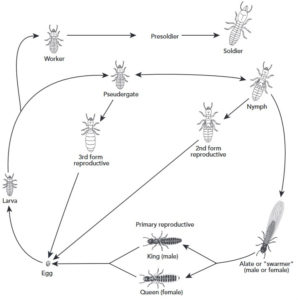
How harmful are flying termites?
Flying termites, AKA alates or termite swarmers, are reproductive termites that leave their colonies in search of a mate to establish a new colony.
Flying termites themselves are not directly harmful to humans. They don’t bite and they can’t sting.
Their presence in large numbers are alarming as they can indicate the presence of a nearby termite colony.
This is always a cause for concern.
Termites, in general, are known for their ability to cause significant damage to timber structures and other cellulose-containing materials.
Once a termite colony is established, worker termites can feed on the structural components of buildings, leading to potential structural damage.
This damage can be expensive to repair and may compromise the integrity of a structure.
If you encounter flying termites in or around your home, it is essential to take action promptly.
Here are some steps you can consider:
Identify the Source: Try to determine the source of the flying termites. They may be emerging from a nearby termite colony in a large mature tree.
Inspect for Infestation: Look for signs of termite infestation, such as mud tracking on walls, soft wall lings and timbers or lots of discarded wings.
It’s vitally important to determine whether termites have already established a colony in or near your home.
Consult A1 Pest Control Professionals: If you suspect a termite infestation in Sydney, it’s advisable to consult with A1 pest control professionals.
We can conduct a thorough inspection and, if necessary, implement appropriate measures to control and eliminate the termite colony.
Preventive Measures: Consider taking preventive measures to protect your home from termite infestations.
This may include regular inspections, removing loose timber from ground contact, addressing moisture issues, and using termite-resistant materials when constructing or renovating.
In summary, while Sydney flying termites themselves are not harmful, their presence can signal the potential for a termite infestation, which can be damaging to structures.
Taking proactive steps to address the issue and implementing preventive measures can help protect your property from the destructive impact of swarming termites.
Alates Formosan Termite Coptotermes formosanus Shiraki
Alates of a swarming termite known as the Formosan subterranean termite Coptotermes formosanus Shiraki (Not known in Sydney Australia), have encountered a swift demise within 48 hours after their swarming in 2002.
Notably, the lifeless cadavers exhibited evident signs of fungal infection. Extracting fungi from these deceased specimens, we meticulously transferred them onto culture media, subsequently isolating them to ensure purity.
Employing these distinct fungal cultures, we conducted experiments infecting Formosan subterranean termite workers.
Remarkably, a singular fungal isolate, denoted as C4-B and taxonomically identified as Metarhizium anisopliae (Metschnikoff), emerged as a potent agent inducing rapid mortality among Formosan subterranean termite alates.
This groundbreaking discovery marks the inaugural instance of a biological control agent effectively targeting swarming, flying termite alates.
Pest Control Services
Our team offer a 100% satisfaction guarantee to keep your home or office under control from pests.
At A1 Pest Control, we believe in first rate customer service.
That is why we ONLY use the safest insecticides that are low toxic and environmentally friendly on your property.
After an urgent termite inspection or pre-purchase pest reports? Call today to find out about our competitive rates.
Throughout the last 40 years, we have built a solid track record for delivery of excellent client service and management of domestic and commercial pest services.
Our Vermin Eradication Programmes Include:
- Spiders
- Ants
- Cockroaches
- Termites (White Ants)
- Rats & Mice (Rodents)
- Pest Reports and Termite Inspections
Our Clients Include:
- Warehouses And Offices
- Commercial And Industrial Sites
- Restaurants And Dining Areas
- Childcare And Early Learning Centres
- Property Management
- Healthcare Facilities
- Government, Schools And Education
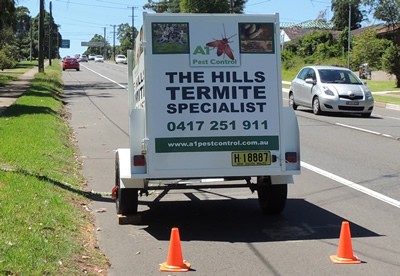
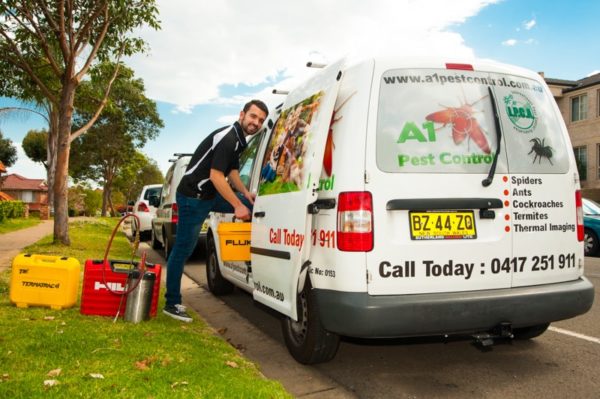
A Local Pest Control Service You Can Trust
We are Commercial Pest Control and Termite Treatment experts. We also have experience and accreditation in Tick Control, Rodent Pest Control and Termite Baits. Need urgent help in the Hills District and North Shore with Termite Inspections Sydney or Flea Treatment Sydney?
Please call Bruce, a termite expert on 0417 251 911 for any questions about termites or emailing bruce@a1pestcontrol.com.au
Our Team at A1 Pest Control are proud to be a 100% Australian-owned service, which is a rarity in our sector. For more than 40 years, we have offered top quality pest control solutions in the Hills area, as well as Upper and Lower North Shore and the Sydney Northern Beaches areas.
We take enormous enjoyment and pride in providing our nearby community and providing a high-quality pest control service that is effective, budget-friendly, and risk-free for adults, children, and pets. If your residence or business needs pest control services, contact us and check out our 100% pest-free assurance.
Termite Control
Termites, or white ants, are the most economically damaging types of pests in the Sydney area.
Termites form colonies and feed on timber structures, causing severe financial problems.
They are the most harmful types of pests that can invade your home, causing a reduction its property value and emotional stress.
Keeping your home termite free is our goal once you engage our highly effective termite treatment services.
Reducing the risk of “white ant” infestation requires expert solutions.
We will perform advanced termite inspections using our highly sensitive thermal imaging termite inspection cameras.
Protect your home or business and keep them pest free by engaging A1 Pest Control.
Our team has an A grade reputation as the Termite Specialists.
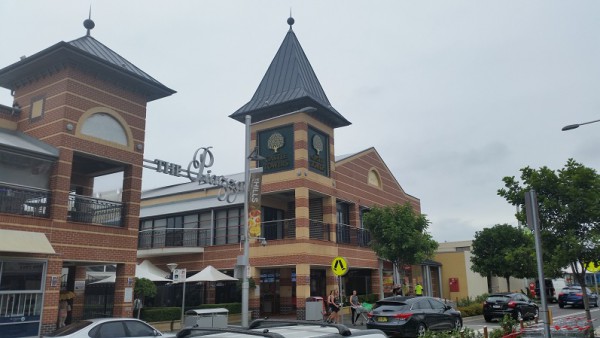
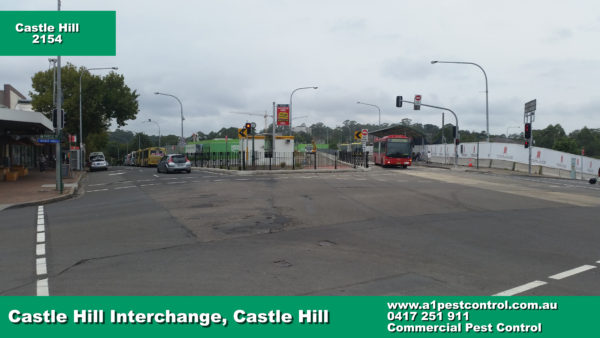
Termite Inspection
The threats of a termite invasion are very real. On average, 1 in 3 homes in Sydney will suffer considerable damage due to a termite infestation, and almost 60% of all properties in Sydney will at one point have a termite problem.
The only way to protect against a termite infestation is a routine termite inspection by professionals. Termite colonies are notoriously difficult to spot and might cause substantial damage before being discovered. A routine termite examination every 12 months is important for keeping your house termite-free. In high-risk areas examinations should happen each 6 months.
When is the last time you checked your property or organisation for termites? Trained specialists at A1 Pest Control Castle Hill specialize in termite control and inspections. Our team even perform thermal termite assessments. Give us a call, and we will be happy to discuss your unique circumstance. Remember, prevention is the best termite control option.
Pest Fumigation Service
What might you do if your property is already at the mercy of termites? There are a number of approaches of managing a termite problem, such as baiting, foaming, chemical barriers, and fumigation.
It is important to note that the kind of treatment used depends on the type of termite infestation. We DO NOT perform termite fumigation.
Fumigation is one of the most effective techniques of termite control in the far northern areas of Australia. However, it is only restricted to the drywood species of termite which DOES NOT appear in NSW.
Fumigation used by other firms also requires substantial use of toxic chemicals (which we never use) and tenting off the house for numerous days while the treatment takes place.
Fumigation is also a generic term used by the layman to describe standard pest treatment.
End of Lease Flea Fumigation
If you own a pet in a domestic or commercial building, it is essential to carry out proper pest control.
If you have a lease agreement, once the lease ends you will be required to carry out a flea treatment by a professional pest firm. It helps avoid re-infestation of fleas to the property occupied by the new tenant.
One of the most annoying types of pests in domestic buildings are fleas. The main sources of a flea infestation are indoor pets such as dogs and cats.
Pets can quickly pick up flea larvae, or grown fleas, while outdoors. They then rapidly transfer them into the home: infesting bed-sheets, carpets, rugs, and other parts of the property.
If your domestic or small business property needs end of lease flea treatment, don’t hesitate to get in touch with A1 Pest Control.
Environmentally Friendly, Low Toxic and Non-Toxic Solutions
A1 Pest Control uses the newest techniques when carrying out pest inspections and treatments, utilising low and non-toxic chemical remedies that are safe for people and pets. What is the use of successful pest control if it renders the home or organisation dwelling unsafe for people to use afterwards? Our team make your overall health and convenience our highest possible concern, and we do so in a way that is environmentally friendly.
A1 Pest Control has rigorous methods and processes that will safeguard your health during and after the treatment method is complete.
Looking for “Pest Control Near Me”?
In case you’re after pest control Sydney (or neighbouring areas) and you need vermin treatment, do not be reluctant to consult with A1 Pest Control.
We are a family business with more than 40 years of expertise in pest control professional services.
Our close by location helps us resolve your pest problems much faster. So, if you are looking for ‘pest control near me’, search no further.
A1 Pest Control offers a wide range of pest control services from termite, ants, rodent treatment, wasp nest removal, end of lease flea treatments, pest reports, and inspections.
Find out why A1 Pest Control has an impeccable pest control reputation in the Sydney area.
How to get rid of flying termites in Australia
Dealing with flying termites, also known as alates or termite swarmers, is best left with professionals like A1 Pest Control Sydney. Don’t be foolhardy and get rid of termite baiting opportunities that can control the colony/s and save you a bucket of money.
There are various methods you can try to address the issue without messing it up for the termite technicians. Keep in mind that each situation is different and the most effective approach may depend on the severity of the infestation, environmental conditions or number of other related factors.
So with no responsibility implied or given for any individual situation, here are some helpful tips.
Tips and ideas to help get rid of flying termites in Australia:
- Identify the Species: Determine the specific species of termites you’re dealing with, as different types may require different treatments.
- Consult Professionals: Seek advice from A1 Pest Control professionals for a thorough inspection and appropriate treatment.
- Remove loose timbers and wood debris from ground contact: Clear away any wood debris, such as fallen branches, loose timbers, or old tree stumps, from your property.
- Fix Leaks: Repair any water leaks, as termites are attracted to moisture.
- Ventilation: Ensure proper ventilation in sub-floor spaces to reduce humidity levels.
- Remove Mulch: Termites are attracted to mulch, so consider using alternatives like gravel, pebbles or rubber mulch.
- Proper Drainage: Improve drainage around your home to prevent water accumulation near the foundation.
- Seal Entry Points: Seal cracks and crevices in your home’s roof tiles, floorboards and walls to prevent termite entry.
- Termite-Resistant Materials: Consider using termite-resistant materials for construction or renovation projects.
- For Professional licenced technicians ONLY:
- Chemical Barriers: Apply liquid termiticides around the sub-floor and exterior perimeter of your home as a preventive measure.
- Termite Bait Stations: Install termite bait stations in strategic locations around the property.
- Dust Termiticides: Apply dust termiticides to termite galleries.
Non-Chemical means to kill flying termites, just to get rid of the mess
- Sunlight Exposure: Expose infested wood to direct sunlight, as termites are sensitive to heat.
- Cayenne Pepper: Sprinkle cayenne pepper in affected areas; termites are repelled by its strong scent.
- Mint Oil: Termites dislike the scent of mint; apply mint oil to affected areas.
- Vinegar: Mix vinegar with water and spray it on affected areas.
- Camphor Oil: Use camphor oil as a natural termite repellent to where they can fly inside.
- Bay Leaves: Place bay leaves in areas prone to swarmers in Australia.
- Cucumber Peel: Termites are repelled by cucumber peel; place it near entry points.
- Essential Oils: Use essential oils like clove, tea tree, or eucalyptus to create a termite-repellent spray to kill termite swarmers.
- Naphthalene Balls: Place naphthalene balls in entry points.
- Citrus Spray: Make a citrus spray using citrus peels and water; spray it to kill flying termites.
- Lemon Juice: Mix lemon juice with water and spray it on termite alates.
- Cinnamon Powder: Sprinkle cinnamon powder on the alates.
- Hot Water Treatment: Pour hot water on swarmers to kill them.
- Pesticidal Plants: Plant pest-repelling plants like chrysanthemums around your home.
- Peppermint Oil and Vinegar Mix: Combine peppermint oil and vinegar to create a repellent spray.
- Lavender Oil: Termites are averse to the scent of lavender; use it as an alate repellent.
Treat Tree Stumps: If you have tree stumps, treat them with termiticides.
Hydrogen Peroxide: Mix hydrogen peroxide with water and spray it on affected areas.
Eucalyptus Mulch: Use eucalyptus mulch, which has termite-repelling properties.
Alcohol Spray: Create a solution of alcohol and water to spray on termites.
Seal Wooden Structures: Seal wooden structures with paint or sealant to prevent termite entry.
Flytraps: Use flytraps near light sources to capture flying termites.
Seek Professional Help: If the infestation is severe, consult professional pest control services for effective treatment.
Remember that prevention is key, and regular inspections of your property can help catch termite issues early. Additionally, local regulations and environmental considerations should be taken into account when choosing treatment methods. If in doubt, it’s always advisable to consult with a pest control professional for the most appropriate and effective solutions.
Sydney Flying Termite Regions & Suburbs
Serviced Regions include: Eastern Suburbs, Forest District, Hills District, Hornsby Shire, Inner West, Lower North Shore, North Shore, Northern Beaches, Northern Suburbs, Parramatta, South Western Sydney, St George, Sutherland Shire, Upper North Shore, Western Suburbs and Western Sydney.
This job was from one of our current clients in Castle Hill NSW that was alarmed to see a swarm of termites had settled in cobwebs and external lights in his rear verandah.
Here is another one in Castle Hill where we found the main source of his termite infestation, which was a large gum tree in his front yard.
Alates infest a wall and door frame in North Rocks in Sydney Australia.
This is where the termite swarm was thought to originate from:
Please be aware that some pest management firms advertise that they work in the area, but actually are based much further away.
We are only 5 minutes away from the city centre.
Our working hours are from 8am to 5pm Monday to Friday and Saturday from 10am to 2pm.
Call Bruce directly from 9am to 5pm Monday to Friday and 10am to 2pm on Saturday
Bruce Gow
A1 Pest Control
Opening and Closing Times:
Monday 8am–5pm
Tuesday 8am–5pm
Wednesday 8am–5pm
Thursday 8am–5pm
Friday 8am–5pm
Saturday 10am–2pm
Sunday Closed


